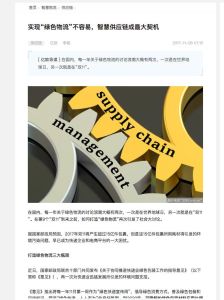
Smart Supply Chain Management May Be The Best Chance To Make "Green Logistics" A Reality
Read or listen offline
Amazon KindleRecommendation
In the lead up to Singles’ Day 2017 – China’s November 11 answer to Black Friday – the Chinese State Post Bureau estimated that the shopping bonanza would result in the shipment of more than 1.5 billion packages. Packaging waste has put green logistics in the spotlight, but progress in the industry has been slow. Li Ni, who reports for business and tech journal Iyiou, outlines green government policies and explains why businesses need to tackle smart supply chain management to facilitate green logistics development. getAbstract recommends this article to those curious about what China is doing to make logistics more environmentally friendly and how the country is moving toward a more sustainable future.
Summary
About the Author
Li Ni is a reporter for the leading business and tech journal Iyiou. She specializes in logistic industry news and developments.


















Comment on this summary